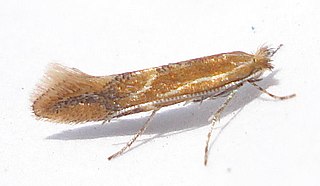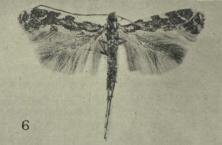
Cameraria is a genus of moths in the family Gracillariidae, which includes many species of leaf miners. One of the best known species is the horse-chestnut leaf miner, Cameraria ohridella.

Philodoria is a genus of moths in the family Gracillariidae. All species are endemic to Hawaii. It was first described by Lord Walsingham in 1907.

Phyllonorycter is a genus of moths in the family Gracillariidae.

Acrocercops is a genus of moths in the family Gracillariidae.
Acrocercops hormista is a moth of the family Gracillariidae. It is known from India and Madagascar.
Acrocercops albomarginatum is a moth of the family Gracillariidae, known from Cuba, Puerto Rico, and the Virgin Islands. The hostplants for the species include Centrosema plumieri and Sida rhombifolia. They mine the leaves of their host plant.
Acrocercops apicepunctella is a moth of the family Gracillariidae, known from Saint Vincent and the Grenadines. It was named by Thomas de Grey, 6th Baron Walsingham in 1891.
Acrocercops attenuatum is a moth of the family Gracillariidae, known from Saint Thomas Island, in the Virgin Islands. The hostplant for the species is Croton flavens.

Acrocercops leucocyma, also known as the kauri leafminer, is a species of moth in the family Gracillariidae. It is endemic to New Zealand.

Acrocercops panacifinens or Eumetriochroa panacifinens is a moth of the family Gracillariidae. It is endemic to New Zealand. In 2019 Robert Hoare and colleagues proposed that this species be provisionally assigned to the genus Eumetriochroa.
Acrocercops demotes is a moth of the family Gracillariidae, known from Mexico. It was described by Walsingham, Lord Thomas de Grey, in 1914.
Acrocercops gemmans is a moth of the family Gracillariidae, known from Mexico. It was described by Walsingham, Lord Thomas de Grey, in 1914.
Acrocercops insulella is a moth of the family Gracillariidae, known from Saint Vincent and the Grenadines and the Dominican Republic. It was described by Walsingham, Lord Thomas de Grey in 1891.
Acrocercops ornata is a moth of the family Gracillariidae, known from Grenada. It was described by Thomas de Grey, 6th Baron Walsingham, in 1897.
Acrocercops marmaritis is a moth of the family Gracillariidae, known from Mexico. It was described by Thomas de Grey, 6th Baron Walsingham, in 1914.
Micropterix cyaneochrysa is a species of moth belonging to the family Micropterigidae that was described by Walsingham, Lord Thomas de Grey, in 1907, and is known from Algeria.

Gracillariinae are a subfamily of moths which was described by Henry Tibbats Stainton in 1854.

Acrocercopinae is a subfamily of moths described by Akito Yuji Kawahara and Issei Ohshima in 2016.






